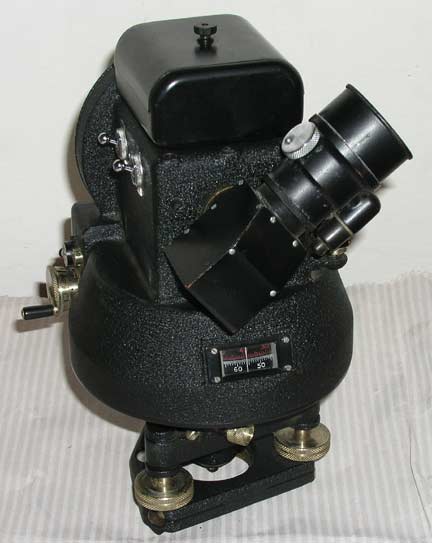E. R. Watts & Son. Ltd., London MK III Balloon Theodolite.
 |
 |
This is the 3rd version of an instrument in a series of theodolites that was the
standard in the meteorological services of the British Commonwealth. They
were designed at the Meteorological Office in collaboration with E. R. Watts
& Son LTD. 5 different models were produced Mk I through MK V.
Mark III through Mark V Models have detachable battery cases, and fixed focus
telescopes. The models were produced as successive improvements over
earlier models.
The Watts Mark III was a transitional design with small numbers produced. It had optics similar to the MK I an MK II and with other features such as a detachable battery case, and use of durable materials similar to the MK IIII and MK V models. This instrument had color filters that fit over the objective rathar than later models where the filters fit over the eyepiece. This instrument has a fixed focus objective and the eyepiece focus is not marked for quick diopter adjustment like later models.
In the photo above Left you can see part of the Met Office Stamp on the instrument base ending in 70. This instrument was not made in 1970, it is a 1943 instrument refurbished in 1970. A number of instruments were done at this time including the Mark IIII instrument photographed on this site. Also there is a reflection in the glass covering the circle readiouts under the eyepiece, they appear the same as the rear of the instrument. Comparing this photo to the Mark III the only visible difference will be the size of the objective optics and prism.
In common with other land based balloon theodolites it has a telescope with a bent optical axis. A secondary wide-angle telescope using the same eyepiece selectable with a mirror. Follow this link for a more detailed description and Cutaway Illustration of a Watts MK I Balloon Theodolite.
Like the vast majority of balloon theodolites the image in inverted when viewed in a Watts theodolite. All Watts Balloon theodolites feature micrometer drums that drive the circles with tangent screws. The tangent screws and micrometers can be disengaged for rapid motion and positively reengaged for accurate tracking. This Mark III was in the service of the Royal Australian Air Force. It was produced in the early 1040's and acquired by me in March 2003.
These theodolites incorporate a lined gradicule to support the tail method of altitude determination. The spacing of the gradicule lines was changed during the evolution of the theodolite series. Slide rules manufactured as early as 1941 (and possibly much sooner) have notes explaining two procedures for calculations based on two gradicule line spacings. A Met. Office Instruction sheet dating May 1927 contains instructions for changing the length of the tail to match the line spacing of the gradicule, but I believe that this is to allow for small variations in the gradicule not, the change in manufacturing.
| Drive Type | Positively Engaging Tangent Screw | Compass | No |
| Display Type | Micrometer .1 degree | Levels | 1 tribrach base plate, 1 Inst, body bubble tube |
| Main Telescope | 35mm 16x 2deg. | Mounting | Tribrach |
| Finder Telescope | 12.5mm
4.5x 8deg. single eyepiece |
Illumination | 2, 3
Volt lamps, scales reticule |
| Gun Site | Yes 1, on finder telescope | Weight (theodolite only) | 8.4 kg |
